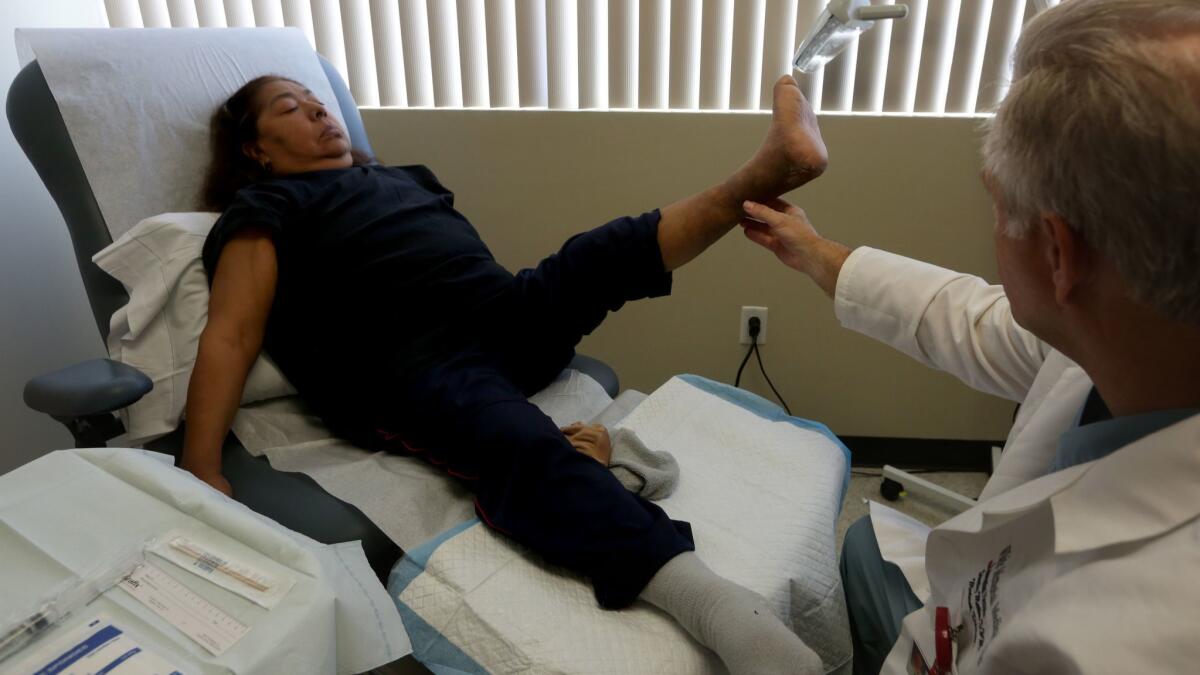What ails America? The answer varies from state to state

The state of the union’s health is improving. But it is doing so very unequally, and recent signs of progress are in danger of being reversed by diseases of excess and despair, including obesity, depression, suicide and substance abuse.
Those are the broad conclusions of a new roundup of Americans’ vital signs published Tuesday in the Journal of the American Medical Assn.
The report is the work of dozens of U.S. public health scholars who are part of an international consortium known as the Global Burden of Disease group. It finds that mortality rates in the United States have declined nearly 22% over 26 years, from 745 deaths per 100,000 people in 1990 to 578 deaths per 100,000 people in 2016.
But those figures obscure substantial geographical variability in Americans’ health and quality of life. And the improvements could readily be swept away by some very dark clouds on the horizon.
In 2016, an American’s average life expectancy at birth ranged from a high of 81.3 years in Hawaii to a low of 74.7 years in Mississippi. If each state were a country, the authors of the report authors noted, Hawaii would be tied with Ireland, ranking 20th worldwide. Mississippi, meanwhile, would tie with Kuwait, ranking 76th in the world.
California’s life expectancy at birth was also among the highest in the nation, coming in second at 80.9 years. Other states with a life expectancy above 80 were Connecticut, Minnesota, New York, Massachusetts, Colorado, New Jersey and Washington.
Hovering at the bottom alongside Mississippi were West Virginia, Alabama, Louisiana, Oklahoma, Kentucky and Arkansas. In none of those states did the average life expectancy at birth reach 76 years.
The geographic disparities “leave the United States far from being united,” wrote Dr. Howard K. Koh of Harvard University and Anand K. Parekh, chief medical advisor of the Washington, D.C.-based Bipartisan Policy Center, in a JAMA editorial that accompanied the report. “Despite notable improvements in some outcomes, the U.S. disease burden is shared unequally.”
One key measure captured states’ unequal levels of health most dramatically: trends in deaths among people 20 to 55.
Some 31 states and the District of Columbia saw this rate of such early death fall between 1990 and 2016. That includes 15 states — led by New York, California and Illinois — where the rate dropped by more than 10%.
But in 21 states, the mortality rate among 20- to 55-year-olds increased. In five states — Kentucky, Oklahoma, New Mexico, West Virginia and Wyoming — it rose by more than 10%.
Heart disease and lung cancer were the No. 1 and No. 2 killers of Americans in 2016, just as they were in 1990. That’s despite real progress over the last 20 years: Reduced smoking rates and more widespread use of treatments to reduce cholesterol and high blood pressure have led to a 33% decline in deaths due to cardiovascular disease for people of all ages.
Self-harm, opioid use disorders and alcohol-related liver diseases all zoomed up the cause-of-death chart. These scourges appeared to drive many of the increases in early deaths seen in states such as West Virginia.
Motor vehicle crashes, meanwhile, dropped from the third-most common cause of death in 1990 to the eighth position in 2016.
Driven by rising rates of obesity, poor diet and insufficient exercise, diseases such as colorectal cancer and diabetes became the fifth- and eighth-most prolific killers of Americans, respectively. And osteoarthritis and diabetes leapfrogged a wide range of conditions to become more important causes of Americans’ disability.
Healthcare costs linked to diabetes ate up close to 5% of all U.S. spending on healthcare, the study noted. That diabetes-related bill was 6.1% higher in 2013 than it was in 1996.
Meanwhile, two perennial complaints — back pain and depression — remained the leading causes of disability among Americans.
In a country where mental healthcare is disorganized, stigmatized and inaccessible to most, 10 million U.S. adults live with a serious mental condition, and more than 7 million people younger than 18 experience a serious emotional disturbance.
All told, three risk factors claimed the highest toll in terms of years lived with a disability in 2016. Tobacco consumption loomed largest in 32 states. Excess weight was the leading cause of disability in 10 states (including California). And in eight states and the District of Columbia, alcohol and drug use contributed most heavily to residents’ disabilities.
The authors of the new report note with alarm that while tobacco use is waning in the United States, rates of obesity and metabolic problems such as high fasting glucose are “steadily increasing.” That’s despite an uptick seen in physical activity, which was, alas, “not enough to control weight gain.”
“These two risk factors pose unique challenges in the United States given that, unabated, they have the potential to change the health trajectory for individuals in many states,” the researchers wrote. “This study calls for renewed effort to control weight gain at the community level” — shifting diet and exercise patterns by changing policies that contribute to Americans’ decisions about food consumption and physical activity.
In 2014, Americans’ life expectancy ranked 43rd in the world, despite the U.S. spending more per person on healthcare than any other country in the world. In their editorial, Koh and Parekh diagnosed a “disconnect” between the nation’s extravagant healthcare spending and its tenuous improvements in health.
They suggested a root cause: Compared to other affluent nations, the United States underspends on social services relative to its investment in medical care, they wrote.
The pair cited earlier findings by their Global Burden of Disease colleagues: that 60% of life-expectancy variation at the county level in the U.S. relates to socioeconomic and race/ethnicity factors.
Koh and Parekh suggested that policymakers can use the comprehensive assessment “to reconsider the current dismal national stance toward disease prevention.”
Healthcare spending is strongly driven by medical conditions that could be reduced or averted with better preventive care and programs that promote healthier choices, they wrote. But such public-health programs have been “long overlooked and underinvested,” they added. Public health programs currently receive only an estimated 2.5% of U.S. healthcare dollars, and a broadly defined raft of prevention programs commands less than 9% of the amount spent on healthcare.
Meanwhile, they noted, the country’s first-ever dedicated stream of funding for public-health programs — which was established by the 2010 Affordable Care Act — is under threat. The Prevention and Public Health Fund, “always short of its intended $2 billion annual budget, has just been cut again in the Bipartisan Budget Act of 2018.”
“Much unfinished business faces the nation collectively and at the state level,” Koh and Parekh wrote.
MORE IN SCIENCE
A finger bone from an unexpected place and time upends the story of human migration out of Africa
Could this drug help the brain recover after a stroke?
Surprise! Scientists find signs of new brain cells in adults as old as 79







